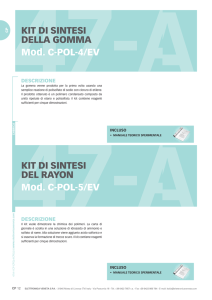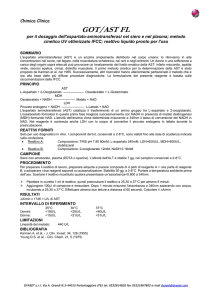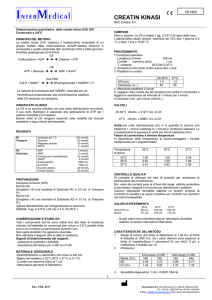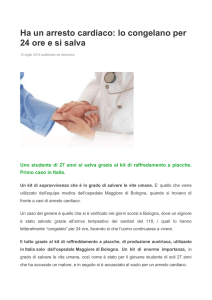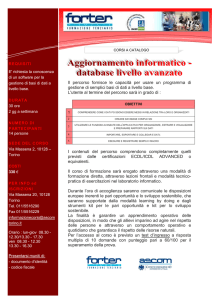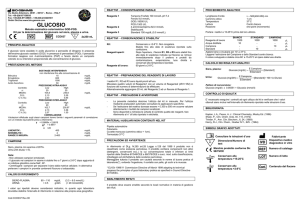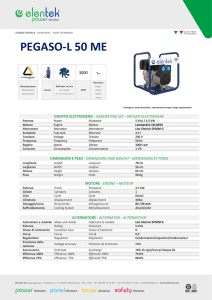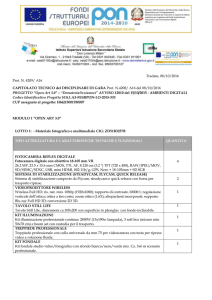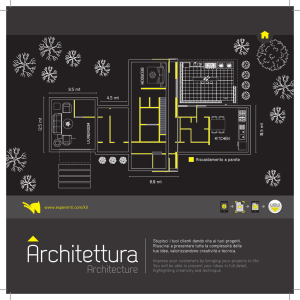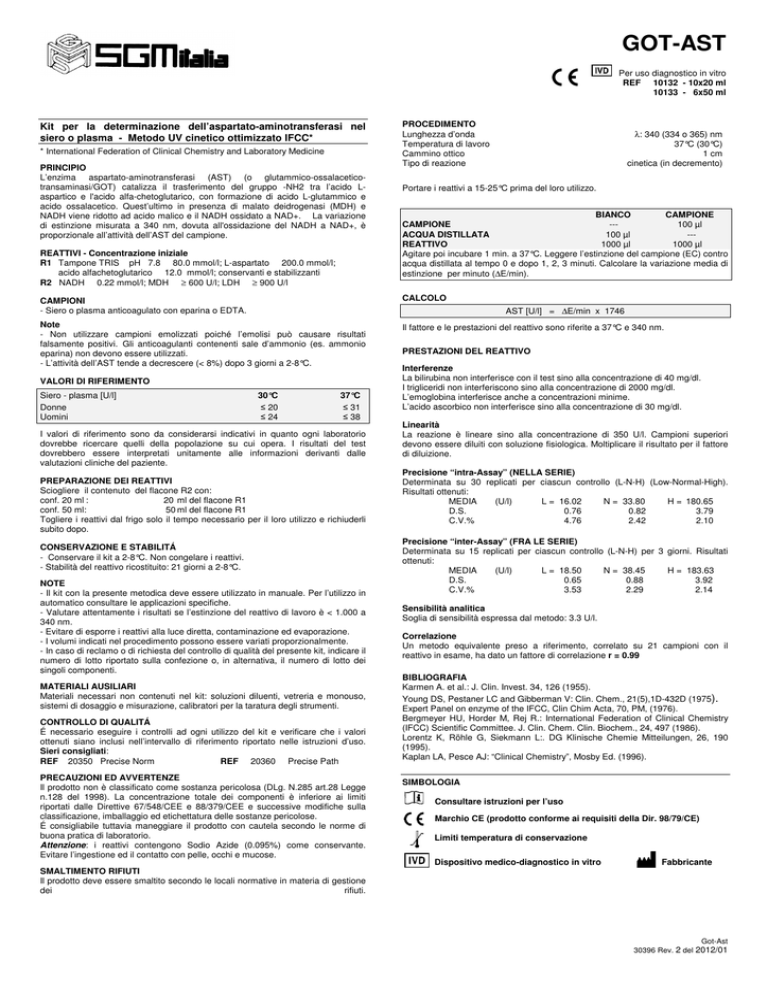
GOT-AST
Per uso diagnostico in vitro
REF 10132 - 10x20 ml
10133 - 6x50 ml
Kit per la determinazione dell’aspartato-aminotransferasi nel
siero o plasma - Metodo UV cinetico ottimizzato IFCC*
* International Federation of Clinical Chemistry and Laboratory Medicine
PRINCIPIO
L’enzima aspartato-aminotransferasi (AST) (o glutammico-ossalaceticotransaminasi/GOT) catalizza il trasferimento del gruppo -NH2 tra l’acido Laspartico e l'acido alfa-chetoglutarico, con formazione di acido L-glutammico e
acido ossalacetico. Quest’ultimo in presenza di malato deidrogenasi (MDH) e
NADH viene ridotto ad acido malico e il NADH ossidato a NAD+. La variazione
di estinzione misurata a 340 nm, dovuta all'ossidazione del NADH a NAD+, è
proporzionale all’attività dell’AST del campione.
REATTIVI - Concentrazione iniziale
R1 Tampone TRIS pH 7.8 80.0 mmol/l; L-aspartato 200.0 mmol/l;
acido alfachetoglutarico 12.0 mmol/l; conservanti e stabilizzanti
R2 NADH 0.22 mmol/l; MDH ≥ 600 U/l; LDH ≥ 900 U/l
PROCEDIMENTO
Lunghezza d’onda
Temperatura di lavoro
Cammino ottico
Tipo di reazione
λ: 340 (334 o 365) nm
37°C (30°C)
1 cm
cinetica (in decremento)
Portare i reattivi a 15-25°C prima del loro utilizzo.
BIANCO
CAMPIONE
CAMPIONE
--100 µl
ACQUA DISTILLATA
100 µl
--REATTIVO
1000 µl
1000 µl
Agitare poi incubare 1 min. a 37°C. Leggere l’estinzione del campione (EC) contro
acqua distillata al tempo 0 e dopo 1, 2, 3 minuti. Calcolare la variazione media di
estinzione per minuto (∆E/min).
CAMPIONI
- Siero o plasma anticoagulato con eparina o EDTA.
CALCOLO
Note
- Non utilizzare campioni emolizzati poiché l’emolisi può causare risultati
falsamente positivi. Gli anticoagulanti contenenti sale d’ammonio (es. ammonio
eparina) non devono essere utilizzati.
- L’attività dell’AST tende a decrescere (< 8%) dopo 3 giorni a 2-8°C.
Il fattore e le prestazioni del reattivo sono riferite a 37°C e 340 nm.
AST [U/l] = ∆E/min x 1746
VALORI DI RIFERIMENTO
Siero - plasma [U/l]
Donne
Uomini
30°C
≤ 20
≤ 24
37°C
≤ 31
≤ 38
I valori di riferimento sono da considerarsi indicativi in quanto ogni laboratorio
dovrebbe ricercare quelli della popolazione su cui opera. I risultati del test
dovrebbero essere interpretati unitamente alle informazioni derivanti dalle
valutazioni cliniche del paziente.
PREPARAZIONE DEI REATTIVI
Sciogliere il contenuto del flacone R2 con:
conf. 20 ml :
20 ml del flacone R1
conf. 50 ml:
50 ml del flacone R1
Togliere i reattivi dal frigo solo il tempo necessario per il loro utilizzo e richiuderli
subito dopo.
CONSERVAZIONE E STABILITÁ
- Conservare il kit a 2-8°C. Non congelare i reattivi.
- Stabilità del reattivo ricostituito: 21 giorni a 2-8°C.
NOTE
- Il kit con la presente metodica deve essere utilizzato in manuale. Per l’utilizzo in
automatico consultare le applicazioni specifiche.
- Valutare attentamente i risultati se l’estinzione del reattivo di lavoro è < 1.000 a
340 nm.
- Evitare di esporre i reattivi alla luce diretta, contaminazione ed evaporazione.
- I volumi indicati nel procedimento possono essere variati proporzionalmente.
- In caso di reclamo o di richiesta del controllo di qualità del presente kit, indicare il
numero di lotto riportato sulla confezione o, in alternativa, il numero di lotto dei
singoli componenti.
MATERIALI AUSILIARI
Materiali necessari non contenuti nel kit: soluzioni diluenti, vetreria e monouso,
sistemi di dosaggio e misurazione, calibratori per la taratura degli strumenti.
CONTROLLO DI QUALITÁ
É necessario eseguire i controlli ad ogni utilizzo del kit e verificare che i valori
ottenuti siano inclusi nell’intervallo di riferimento riportato nelle istruzioni d’uso.
Sieri consigliati:
REF 20350 Precise Norm
REF 20360 Precise Path
PRECAUZIONI ED AVVERTENZE
Il prodotto non è classificato come sostanza pericolosa (DLg. N.285 art.28 Legge
n.128 del 1998). La concentrazione totale dei componenti è inferiore ai limiti
riportati dalle Direttive 67/548/CEE e 88/379/CEE e successive modifiche sulla
classificazione, imballaggio ed etichettatura delle sostanze pericolose.
É consigliabile tuttavia maneggiare il prodotto con cautela secondo le norme di
buona pratica di laboratorio.
Attenzione: i reattivi contengono Sodio Azide (0.095%) come conservante.
Evitare l’ingestione ed il contatto con pelle, occhi e mucose.
SMALTIMENTO RIFIUTI
Il prodotto deve essere smaltito secondo le locali normative in materia di gestione
dei
rifiuti.
PRESTAZIONI DEL REATTIVO
Interferenze
La bilirubina non interferisce con il test sino alla concentrazione di 40 mg/dl.
I trigliceridi non interferiscono sino alla concentrazione di 2000 mg/dl.
L’emoglobina interferisce anche a concentrazioni minime.
L’acido ascorbico non interferisce sino alla concentrazione di 30 mg/dl.
Linearità
La reazione è lineare sino alla concentrazione di 350 U/l. Campioni superiori
devono essere diluiti con soluzione fisiologica. Moltiplicare il risultato per il fattore
di diluizione.
Precisione “intra-Assay” (NELLA SERIE)
Determinata su 30 replicati per ciascun controllo (L-N-H) (Low-Normal-High).
Risultati ottenuti:
MEDIA
(U/l)
L = 16.02
N = 33.80
H = 180.65
D.S.
0.76
0.82
3.79
C.V.%
4.76
2.42
2.10
Precisione “inter-Assay” (FRA LE SERIE)
Determinata su 15 replicati per ciascun controllo (L-N-H) per 3 giorni. Risultati
ottenuti:
MEDIA
(U/l)
L = 18.50
N = 38.45
H = 183.63
D.S.
0.65
0.88
3.92
C.V.%
3.53
2.29
2.14
Sensibilità analitica
Soglia di sensibilità espressa dal metodo: 3.3 U/l.
Correlazione
Un metodo equivalente preso a riferimento, correlato su 21 campioni con il
reattivo in esame, ha dato un fattore di correlazione r = 0.99
BIBLIOGRAFIA
Karmen A. et al.: J. Clin. Invest. 34, 126 (1955).
Young DS, Pestaner LC and Gibberman V: Clin. Chem., 21(5),1D-432D (1975).
Expert Panel on enzyme of the IFCC, Clin Chim Acta, 70, PM, (1976).
Bergmeyer HU, Horder M, Rej R.: International Federation of Clinical Chemistry
(IFCC) Scientific Committee. J. Clin. Chem. Clin. Biochem., 24, 497 (1986).
Lorentz K, Röhle G, Siekmann L:. DG Klinische Chemie Mitteilungen, 26, 190
(1995).
Kaplan LA, Pesce AJ: “Clinical Chemistry”, Mosby Ed. (1996).
SIMBOLOGIA
Consultare istruzioni per l’uso
Marchio CE (prodotto conforme ai requisiti della Dir. 98/79/CE)
Limiti temperatura di conservazione
Dispositivo medico-diagnostico in vitro
Fabbricante
Got-Ast
30396 Rev. 2 del 2012/01
GOT-AST
For in vitro medical device
REF 10132 - 10x20 ml
10133 - 6x50 ml
Kit for measurement of aspartate-aminotransferase in serum or
plasma - Kinetic UV optimized method IFCC*
* International Federation of Clinical Chemistry and Laboratory Medicine
PRINCIPLE
The enzyme aspartate-aminotransferase (AST) (or glutamic-oxaloacetic
transaminase/GOT) catalyzes reaction between alpha-ketoglutarate and Laspartate giving glutamate and oxaloacetate. In presence of malate
dehydrogenase (MDH), oxaloacetate reacts with NADH giving malate and NAD+.
The change of absorbance measured at 340 nm is proportional to the AST activity
of the sample.
REAGENTS
R1 TRIS buffer pH 7.8 80.0 mmol/l; L-aspartate 200.0 mmol/l;
alpha-ketoglutarate acid 12.0 mmol/l; preservatives and stabilizers
R2 NADH 0.22 mmol/l ; MDH ≥ 600 U/l; LDH ≥ 900 U/l
λ: 340 (334 o 365) nm
37°C (30°C)
1 cm
kinetic (decreasing)
Bring the reagents at 15-25°C before using them.
BLANK
SAMPLE
SAMPLE
--100 µl
DISTILLED WATER
100 µl
--REAGENT
1000 µl
1000 µl
Mix, then incubate for 1’ a 37°C. Measure the absorbance of sample (EC) against
distilled water every minute during 3 minutes. Calculate the average absorbance
difference per minute (∆E/min).
CALCULATION
SAMPLE
- Serum-heparinized plasma or EDTA plasma.
AST [U/l] = ∆E/min x 1746
Note
- Do not use samples with haemolysis because this one could cause results
wrongly positive. The anticoagulants containing ammonium salt (es. ammonium
heparinate) mustn’t be used.
- The AST activity tends to decrease (< 8%) after 3 days at 2-8°C.
REFERENCE VALUES
Serum - plasma [U/l]
Women
Men
PROCEDURES
Wavelength
Working temperature
Optical path
Reaction
30°C
≤ 20
≤ 24
37°C
≤ 31
≤ 38
References values are considered indicatives since each laboratory should
establish references ranges for its own patient’s population. The analytical results
should be evaluated with other information coming from patient’s clinical story.
PREPARATION OF REAGENTS
Dissolve the content of R2 vial with:
vial 20 ml:
20 ml of R1 solution
vial 50 ml:
50 ml of R1 solution
Keep out the reagents from refrigerator only for the use and recap them
immediately.
STORAGE AND STABILITY
- Store the kit at 2-8°C. Do not freeze the reagents.
- Reconstituted reagent stability: 21 days at 2-8°C.
NOTE
- The kit, according to this method, must be used in manual procedures. About
automatic using follow specific applications.
- Evaluate carefully the results if working reagent absorbance is < 1.000 at
340 nm.
- Avoid direct light, contamination and evaporation.
- The volumes in the procedure can be changed proportionally.
- In case of complaint or quality control request, refer to the lot number on the
package or the lot number on the singles vials.
AUXILIARY EQUIPMENT
Materials not included in the kit: diluent solutions, laboratory glassware,
disposable tips, photometers and calibrators.
QUALITY CONTROLS
It’s necessary, every time the kit is used, to make the quality controls and to check
that values obtained are within the acceptance range provided in the insert.
Suggested serum:
REF 20350 Precise Norm
REF 20360 Precise Path
PRECAUTION IN USE
The product is not classified as dangerous (DLg. N. 285 art. 28 l. n. 128/1998).
The total concentration of components is lower than the limits reported by 67/548
and 88/379 CE Regulations (and following modifications) about classification,
packaging and labelling of dangerous substances.
However the reagent should be handled with caution, according to good laboratory
practice.
Caution: the reagents contain Sodium Azide (0.095%) as preservative. Avoid
swallowing and contacting with skin, eyes and mucous membranes.
The factor and the reagent performances are related to 37°C and 340 nm.
ANALYTICAL PERFORMANCES
Interferences
Bilirubin does not interfere up to concentration of 40 mg/dl.
Triglycerides do not interfere up to concentration of 2000 mg/dl.
Hemoglobin interferes also at minimum concentrations.
Ascorbate acid does not interfere up to concentration of 30 mg/dl.
Linearity
Reaction is linear up to a concentration of 350 U/l. Samples with values exceeding
this range must be diluted with saline solution. Multiply, then, the result for diluting
factor.
“Intra-Assay” precision (within-Run)
Determined on 30 samples for each control (L-N-H) (Low-Normal-High).
Results:
MEAN
(U/l)
L = 16.02
N = 33.80
H = 180.65
S.D.
0.76
0.82
3.79
C.V.%
4.76
2.42
2.10
“Inter-Assay” precision (between-run)
Determined on 15 samples for each control (L-N-H) for 3 days.
Results:
MEAN
(U/l)
L = 18.50
N = 38.45
S.D.
0.65
0.88
C.V.%
3.53
2.29
H = 183.63
3.92
2.14
Analytical sensitivity
The test sensitivity in terms of detection limit is 3.3 U/l.
Correlation
A study based comparing this method with a similar method on 21 samples has
given a correlating factor r = 0.99
BIBLIOGRAPHY
Karmen A. et al.: J. Clin. Invest. 34, 126 (1955).
Young DS, Pestaner LC and Gibberman V: Clin. Chem., 21(5),1D-432D (1975).
Expert Panel on enzyme of the IFCC, Clin Chim Acta, 70, PM, (1976).
Bergmeyer HU, Horder M, Rej R.: International Federation of Clinical Chemistry
(IFCC) Scientific Committee. J. Clin. Chem. Clin. Biochem., 24, 497 (1986).
Lorentz K, Röhle G, Siekmann L:. DG Klinische Chemie Mitteilungen, 26, 190
(1995).
Kaplan LA, Pesce AJ: “Clinical Chemistry”, Mosby Ed. (1996).
SYMBOLS
Read instruction for use
CE mark (requirement of 98/79 regulation)
Storaging temperature limits
In vitro medical device
Producer
WASTE MANAGEMENT
Please refer to the local legal requirements.
Got-Ast
30396 Rev. 2 of 2012/01

